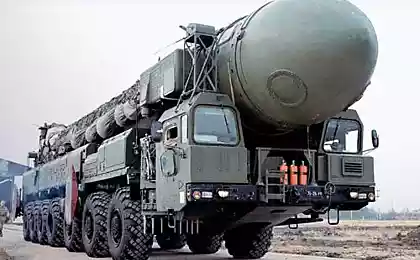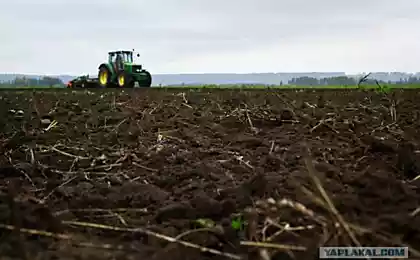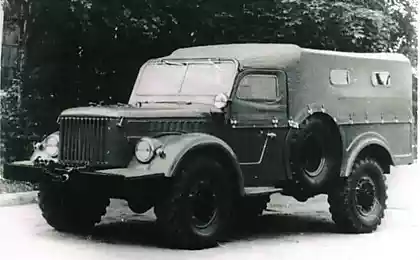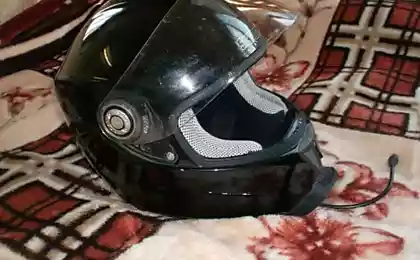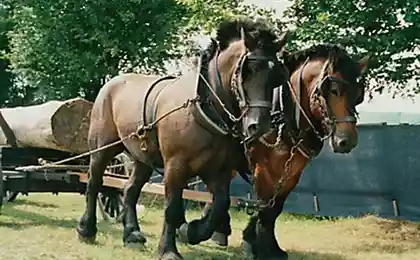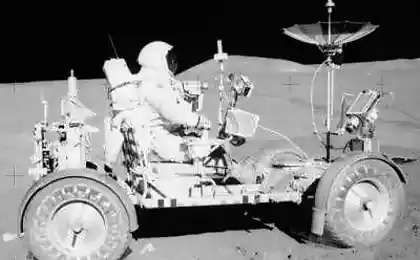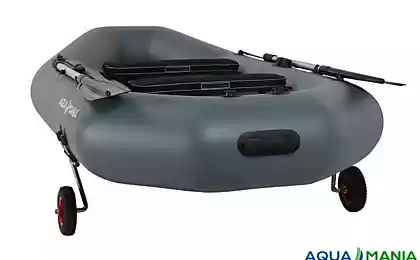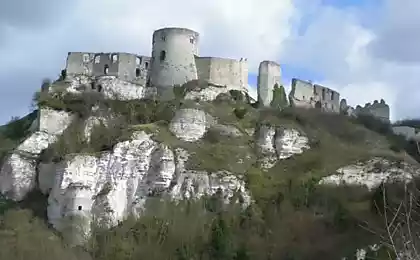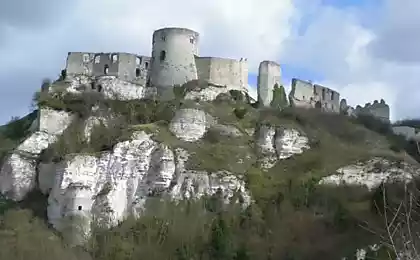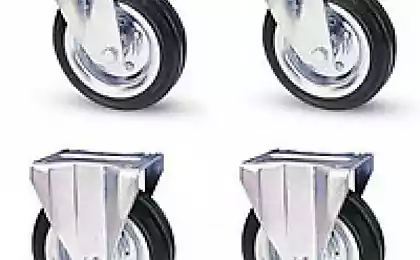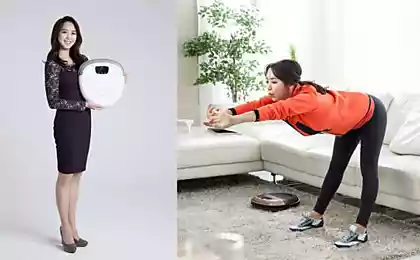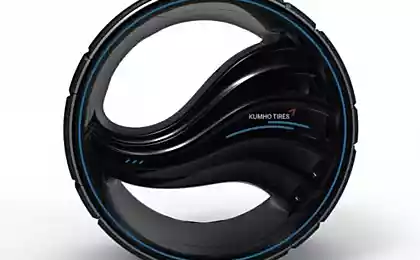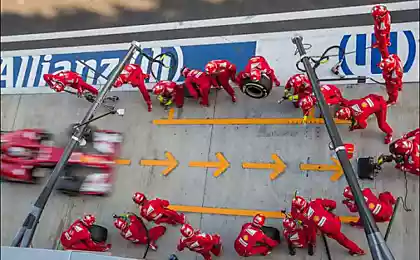2826
Sculptures made of caps for wheels
Briton Ptolemy Elrington (Ptolemy Elrington) is committed to collecting Landfill and roadsides caps on the wheels, which makes here in such an interesting sculpture.
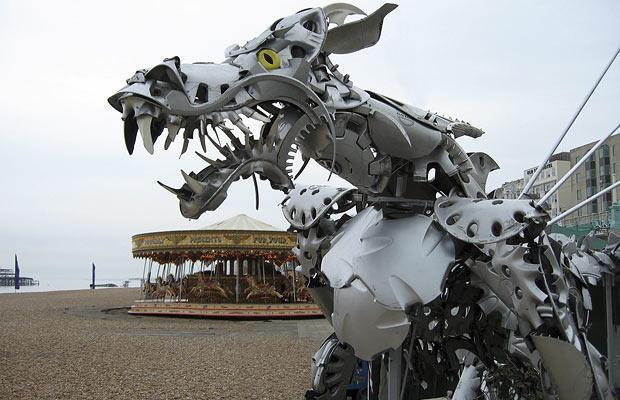
Interestingly !!!
If all thrown out on the uselessness of things could talk, they'd love to tell how happy that I have found a second life and can again delight us with their presence. However, if you look at the graceful dragonfly collected from twigs of the old shopping cart, or the majestic eagle of automotive wheel caps, and so all is clear. In vain we throw away so much unnecessary-necessary things! Incidentally, in the English town of Brighton is a long time to understand and hard to help local sorcerer Ptolemy Elrington (Ptolemy Elrington) created from any metal and plastic waste are real masterpieces of art.
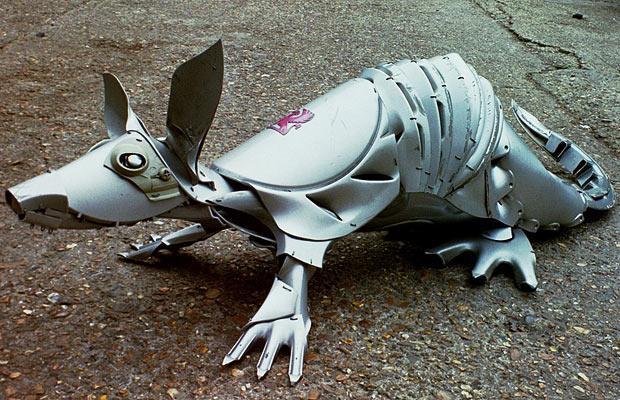
Looking ideas
What is creativity and how to live with him, Ptolemy grasped as a child. That only is its unusual name - Peter Charles Ptolemy Elrington, because of which had to go through many adventures in school. Parents, being creative people, not only in parts of the country "imenivydumyvaniya" (father - actor and theater director, his mother - a housewife, passionately fond of painting), strongly taught his son to seek internal talent and encourage any inventive impulses. So, armed with the slogan "always do what you like, not what you want," Ptolemy enrolled in courses of artistic college in Lincoln, where he received his basic knowledge of sculpture, wood carving, working with clay and wire. < br />
Innovative artistic taste manifested in the Bradford College where inquisitive boy postu- drank in order to further explore the basics of art and design. So, no matter what experienced teachers, no matter what the truth is not proclaimed Elrington polite with all soglashal- camping, but ... did everything on his own. And, in the end, completely disillusioned with the art environment, where all kinds of artistic trends imposed and a marketing ploy for financial gain, Ptolemy, his diploma, "dismissed" themselves from the world of art. For several years he worked part time seasonal work: a carpenter, the roofer, the driver.

Everything changed India. Returning in 1998 from a trip to this exotic country, Ptolemy Elrington suddenly realized what he wanted to do. "I saw people living in extreme poverty, can do amazing things literally from all that lies beneath our feet, - says Arlington. - Particularly struck by how they use, adapt and repair the seemingly uninsurable fix things ».
So began the first artistic experiments with debris, in particular, thrown caps for automobile wheels.
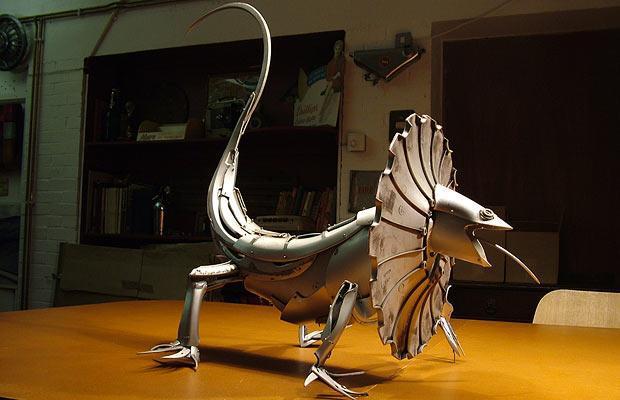
Improvisation meanings
At first glance, what the aesthetic value of a pile of dirty of a broken metal? No. And if you dream a little, then bend, cut, weld and here - goes something soulful, inexplicably showing a special sense of urban reality and its waste.
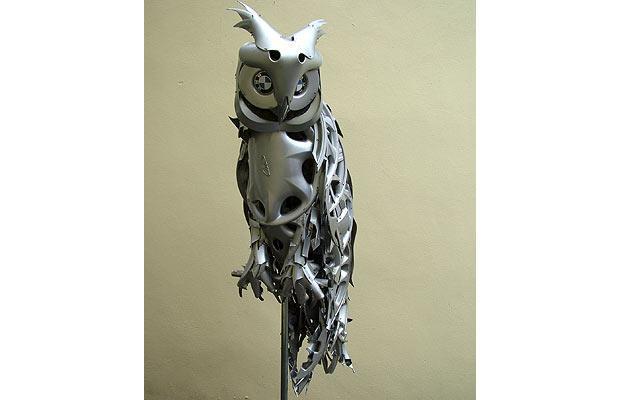
Since imagination Ptolemy all came, and the necessary material - at least a dime a dozen on the roadsides and in the city dump in Brighton studio, where he settled artist, work started. What seemed rubbish, within two or three days it became the epitome of graceful sculptures of birds, dragons, dogs, octopus, crabs, crocodiles, and especially fish.
Master passion to the inhabitants of the sea floor - a special theme. Firstly, metal caps on their characteristics were ideal for assembly konstru- Ktorov miracle fish. Secondly, in order to properly convey the nature of the planned character, "Iron Merlin" sits for hours in the library or sent to the Brighton Aquarium to see how moving water shark or electric ray.
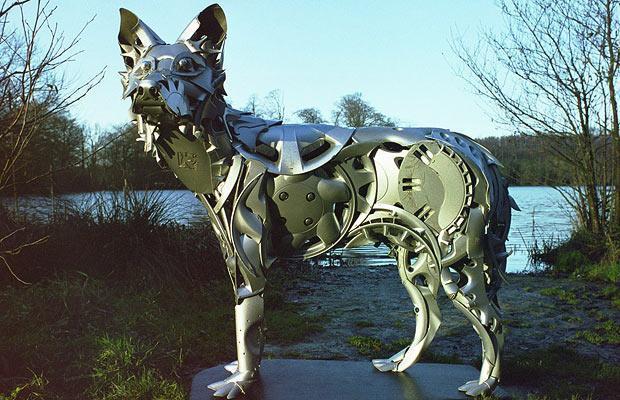
To the original idea was embodied in something tangible, you need quite a bit: wire frame, cutter, hacksaw, drill, file, a pair of pliers and ... a lot of the patch. Creator garbage installations all the time hurt his hands. But for such a little "accident" Ptolemy Elrington is philosophical, because it is also part of the creative process. "I like to do everything by hand and see how a pile of iron gradually modified, - he said. - I like to deal with a drill, especially when to work with it requires two hands, but I can use only one, because the second hand keeps the sculpture. One even had a chance to hold the handle of the tool teeth, but the vibrations just do not fall out teeth, had to find another way out ».
Successful turnaround
Of course, not notice a huge mountain of old automobile hoods and that one turns out, it was difficult. Therefore, it is a fascinating hobby soon turned into a good business. The main customers of steel bars, hotels, shops, car dealers, owners appreciated innovative "Resurrection" piece of iron. For example, in the lobby Brighton pub The Hop-Poles settled colorful crocodile, and on the ceiling spread tentacles giant octopus iron. Restaurant The Eagle commissioned a sculpture of an eagle, office showroom Adams & Webb in North London umostilsya imposing dragon. Those visitors who admire this stainless livestock, hastened to contact the author of that book myself and unusual "garbage" instance.
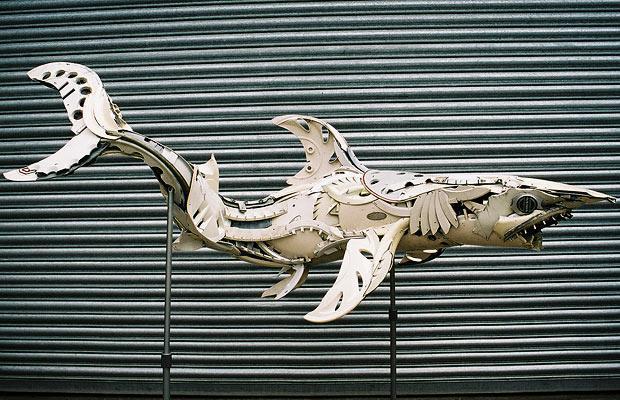
However, the designer received universal recognition through participation in charitable actions Rivercare, organized by a local water companies. The event, calling to take care of nature and do not clutter up the environment was clean nearest reservoirs volunteers. And one of the organizers remembered that lives in an eccentric capable of any piece of trash transformed into a work of art. As a result, Ptolemy was commissioned to create Danie ten sculptures, but not from the hoods, and of the old shopping carts found in ponds during the clean-up or on the outskirts of the roads.
First square shape carts and mesh bars dejected Ptolemy. But, worn out with new material and having mastered the special welding system, smart Englishman built a remarkably graceful installation ten creatures: heron, dragonfly, frog, water rats, and others. The residents of Brighton gasped in surprise, seeing transforms ordinary truck, which they pushed every day in the supermarket. The Organising Company has received several awards for holding such artistic action, and the "iron master" - the media attention and new orders. By the way, the average cost of a sculpture from car hoods today ranges from GBP120 to GBP600. More difficult job costing customers in GBP1, 5-2, 5 thousand.
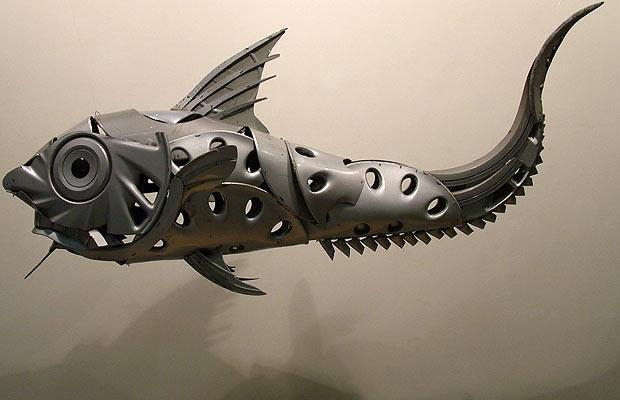
But that's not the profit, or even to recognize the talents of English artist. How is regarded as Ptolemy, he was able to realize his dream home - not to sit in stuffy offices, and do what you like. In addition, the work brings not only fun, but also benefit the whole of the surrounding world. Not everyone can boast such.
Trash transformation
E steticheskaya value and expressive means of garbage have been disclosed in the early twentieth century. So, dadaist collages of Kurt Schwitters were full of various "fragments of reality": tram tickets, scraps of posters, covers of cans, ropes. Topic garbage developed many representatives of pop art (Robert Rauschenberg, Claes Oldenburg, and others.).
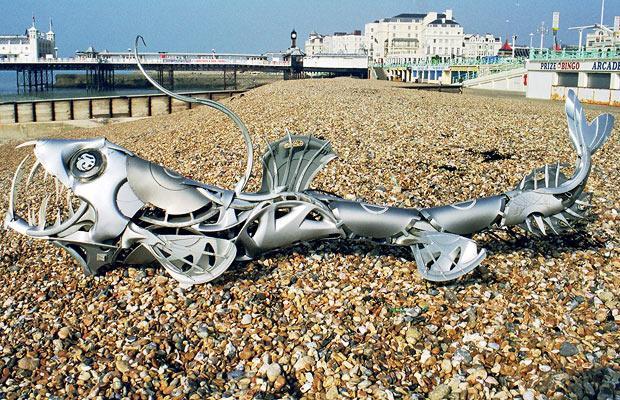
Now artistic processing of urban waste - common trend in art. In March this year appeared in the center of Rome in 1000 statues made of tin cans, computer parts and other stuff. Author shocking exhibition entitled "Peaceful invasion" - German sculptor Ha Schult annual showcase their work in different countries. His "artistic trash" has been on the Red Square in Moscow, near the pyramids in Egypt and the Great Wall of China.
Unique sculpture of dust, lint, scraps of wool, hair, cherry stones and twigs constructs British monumentalistka Rebecca Warren. Such ingenuity brought her worldwide fame and a nomination for the award Turner (GBP25 thousand.) - The most prestigious award in the world of fine arts and monumental UK.

Short interview
In contrast to ordinary people's eyes see fine artist, even in fetid slums or the city dump. Why did Ptolemy Elrington instead of noble clay and watercolors chose ordinary trash?
- In the world of a lot of different stuff. Why car hoods?
- I'm from the category of people who are always being dragged into the house found somewhere in the old audio system, lights, different zhelezya- ki. Repair of rework. If you see that sticks out of the dumpster couple jerk feet - that's for sure my (laughs). I always like to create from their finds something new. From automobile hoods, here, was going to make armor. But it turned out that they make excellent fish sculptures.
- And now it has become your specialty?
- In part, yes. I can make any animal, bird, insect, but in the end the fish look best. And the more I do them, the more I am attracted by the process of construction. After all, the end result is only 50% dependent on the original idea, everything else - material properties: shiny silver surface of the cover is great for creating scales.
- Where do you find so many caps?
- I started collecting them for more than six years ago, picked up on the way to work when he worked as a laborer. Besides, I always help friends, family, so now I have a whole warehouse. Most striking strangers who decide to stop, pick up the iron trash and bring to me, knowing that I will be able to use it. Every time that as a compliment and confirmation that I'm doing something worthwhile.
- You do not mind that it's still not marble or watercolors, and ordinary trash?
- All the objects around us - beautiful and valuable. But everyone refers to them subjectively. I often met with thrown objects, which makes much more sense than their "unnecessary". For example, caps on vehicles used only for aesthetic purposes and automatically become trash once it is on the edge of the road. But with small effort and imagination I transform them into something that can again delight the human eye. In fact, my sculptures are trying to say about our wasteful society and prejudices about the value of things.
- What do you like most about your job?
- The process of creation! How the initial idea is embodied in the design of the pieces, as you have to fight with the properties of the material, trying to follow the idea of the shape. Sometimes discover that turns out not what initially conceived (once the fish has become a happy sperm, and the toad became incredibly octopus). But most of all is fun attitude of those strangers who come to me to get close to a road caps and thought: "This is - not a piece of garbage, it's something that can be useful Ptolu».


Interestingly !!!
If all thrown out on the uselessness of things could talk, they'd love to tell how happy that I have found a second life and can again delight us with their presence. However, if you look at the graceful dragonfly collected from twigs of the old shopping cart, or the majestic eagle of automotive wheel caps, and so all is clear. In vain we throw away so much unnecessary-necessary things! Incidentally, in the English town of Brighton is a long time to understand and hard to help local sorcerer Ptolemy Elrington (Ptolemy Elrington) created from any metal and plastic waste are real masterpieces of art.

Looking ideas
What is creativity and how to live with him, Ptolemy grasped as a child. That only is its unusual name - Peter Charles Ptolemy Elrington, because of which had to go through many adventures in school. Parents, being creative people, not only in parts of the country "imenivydumyvaniya" (father - actor and theater director, his mother - a housewife, passionately fond of painting), strongly taught his son to seek internal talent and encourage any inventive impulses. So, armed with the slogan "always do what you like, not what you want," Ptolemy enrolled in courses of artistic college in Lincoln, where he received his basic knowledge of sculpture, wood carving, working with clay and wire. < br />
Innovative artistic taste manifested in the Bradford College where inquisitive boy postu- drank in order to further explore the basics of art and design. So, no matter what experienced teachers, no matter what the truth is not proclaimed Elrington polite with all soglashal- camping, but ... did everything on his own. And, in the end, completely disillusioned with the art environment, where all kinds of artistic trends imposed and a marketing ploy for financial gain, Ptolemy, his diploma, "dismissed" themselves from the world of art. For several years he worked part time seasonal work: a carpenter, the roofer, the driver.

Everything changed India. Returning in 1998 from a trip to this exotic country, Ptolemy Elrington suddenly realized what he wanted to do. "I saw people living in extreme poverty, can do amazing things literally from all that lies beneath our feet, - says Arlington. - Particularly struck by how they use, adapt and repair the seemingly uninsurable fix things ».
So began the first artistic experiments with debris, in particular, thrown caps for automobile wheels.

Improvisation meanings
At first glance, what the aesthetic value of a pile of dirty of a broken metal? No. And if you dream a little, then bend, cut, weld and here - goes something soulful, inexplicably showing a special sense of urban reality and its waste.

Since imagination Ptolemy all came, and the necessary material - at least a dime a dozen on the roadsides and in the city dump in Brighton studio, where he settled artist, work started. What seemed rubbish, within two or three days it became the epitome of graceful sculptures of birds, dragons, dogs, octopus, crabs, crocodiles, and especially fish.
Master passion to the inhabitants of the sea floor - a special theme. Firstly, metal caps on their characteristics were ideal for assembly konstru- Ktorov miracle fish. Secondly, in order to properly convey the nature of the planned character, "Iron Merlin" sits for hours in the library or sent to the Brighton Aquarium to see how moving water shark or electric ray.

To the original idea was embodied in something tangible, you need quite a bit: wire frame, cutter, hacksaw, drill, file, a pair of pliers and ... a lot of the patch. Creator garbage installations all the time hurt his hands. But for such a little "accident" Ptolemy Elrington is philosophical, because it is also part of the creative process. "I like to do everything by hand and see how a pile of iron gradually modified, - he said. - I like to deal with a drill, especially when to work with it requires two hands, but I can use only one, because the second hand keeps the sculpture. One even had a chance to hold the handle of the tool teeth, but the vibrations just do not fall out teeth, had to find another way out ».
Successful turnaround
Of course, not notice a huge mountain of old automobile hoods and that one turns out, it was difficult. Therefore, it is a fascinating hobby soon turned into a good business. The main customers of steel bars, hotels, shops, car dealers, owners appreciated innovative "Resurrection" piece of iron. For example, in the lobby Brighton pub The Hop-Poles settled colorful crocodile, and on the ceiling spread tentacles giant octopus iron. Restaurant The Eagle commissioned a sculpture of an eagle, office showroom Adams & Webb in North London umostilsya imposing dragon. Those visitors who admire this stainless livestock, hastened to contact the author of that book myself and unusual "garbage" instance.

However, the designer received universal recognition through participation in charitable actions Rivercare, organized by a local water companies. The event, calling to take care of nature and do not clutter up the environment was clean nearest reservoirs volunteers. And one of the organizers remembered that lives in an eccentric capable of any piece of trash transformed into a work of art. As a result, Ptolemy was commissioned to create Danie ten sculptures, but not from the hoods, and of the old shopping carts found in ponds during the clean-up or on the outskirts of the roads.
First square shape carts and mesh bars dejected Ptolemy. But, worn out with new material and having mastered the special welding system, smart Englishman built a remarkably graceful installation ten creatures: heron, dragonfly, frog, water rats, and others. The residents of Brighton gasped in surprise, seeing transforms ordinary truck, which they pushed every day in the supermarket. The Organising Company has received several awards for holding such artistic action, and the "iron master" - the media attention and new orders. By the way, the average cost of a sculpture from car hoods today ranges from GBP120 to GBP600. More difficult job costing customers in GBP1, 5-2, 5 thousand.

But that's not the profit, or even to recognize the talents of English artist. How is regarded as Ptolemy, he was able to realize his dream home - not to sit in stuffy offices, and do what you like. In addition, the work brings not only fun, but also benefit the whole of the surrounding world. Not everyone can boast such.
Trash transformation
E steticheskaya value and expressive means of garbage have been disclosed in the early twentieth century. So, dadaist collages of Kurt Schwitters were full of various "fragments of reality": tram tickets, scraps of posters, covers of cans, ropes. Topic garbage developed many representatives of pop art (Robert Rauschenberg, Claes Oldenburg, and others.).

Now artistic processing of urban waste - common trend in art. In March this year appeared in the center of Rome in 1000 statues made of tin cans, computer parts and other stuff. Author shocking exhibition entitled "Peaceful invasion" - German sculptor Ha Schult annual showcase their work in different countries. His "artistic trash" has been on the Red Square in Moscow, near the pyramids in Egypt and the Great Wall of China.
Unique sculpture of dust, lint, scraps of wool, hair, cherry stones and twigs constructs British monumentalistka Rebecca Warren. Such ingenuity brought her worldwide fame and a nomination for the award Turner (GBP25 thousand.) - The most prestigious award in the world of fine arts and monumental UK.

Short interview
In contrast to ordinary people's eyes see fine artist, even in fetid slums or the city dump. Why did Ptolemy Elrington instead of noble clay and watercolors chose ordinary trash?
- In the world of a lot of different stuff. Why car hoods?
- I'm from the category of people who are always being dragged into the house found somewhere in the old audio system, lights, different zhelezya- ki. Repair of rework. If you see that sticks out of the dumpster couple jerk feet - that's for sure my (laughs). I always like to create from their finds something new. From automobile hoods, here, was going to make armor. But it turned out that they make excellent fish sculptures.
- And now it has become your specialty?
- In part, yes. I can make any animal, bird, insect, but in the end the fish look best. And the more I do them, the more I am attracted by the process of construction. After all, the end result is only 50% dependent on the original idea, everything else - material properties: shiny silver surface of the cover is great for creating scales.
- Where do you find so many caps?
- I started collecting them for more than six years ago, picked up on the way to work when he worked as a laborer. Besides, I always help friends, family, so now I have a whole warehouse. Most striking strangers who decide to stop, pick up the iron trash and bring to me, knowing that I will be able to use it. Every time that as a compliment and confirmation that I'm doing something worthwhile.
- You do not mind that it's still not marble or watercolors, and ordinary trash?
- All the objects around us - beautiful and valuable. But everyone refers to them subjectively. I often met with thrown objects, which makes much more sense than their "unnecessary". For example, caps on vehicles used only for aesthetic purposes and automatically become trash once it is on the edge of the road. But with small effort and imagination I transform them into something that can again delight the human eye. In fact, my sculptures are trying to say about our wasteful society and prejudices about the value of things.
- What do you like most about your job?
- The process of creation! How the initial idea is embodied in the design of the pieces, as you have to fight with the properties of the material, trying to follow the idea of the shape. Sometimes discover that turns out not what initially conceived (once the fish has become a happy sperm, and the toad became incredibly octopus). But most of all is fun attitude of those strangers who come to me to get close to a road caps and thought: "This is - not a piece of garbage, it's something that can be useful Ptolu».



